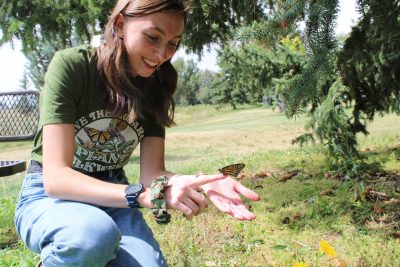A recent University of Wyoming graduate learned that a parasite that has led to the decline of monarch butterflies around the globe does not appear to be present in the specific butterfly species in east-central Wyoming.
That parasite, known as Ophryocystis elektroacirrha, or OE, can cause wings to malform and, thus, decrease the migration success of monarch butterflies.
“The main takeaway from our paper is that a parasite affecting monarch populations across the country was not found in our study area in Wyoming, which is a great sign,” says Zoë Short, a spring 2023 UW graduate from Douglas who received her bachelor’s degree in zoology. “This means that monarchs in Wyoming may have better migratory success than monarchs in regions with high parasitism because high parasite loads can cause wing malformations and decrease migration success.”

Short was lead author of a paper titled “Monarchs Reproduced in Eastern Wyoming and Were Not Parasitized by Ophryocystis elektroacirrha” that was published online on Feb. 2 in Prairie Naturalist, a peer-reviewed natural history science journal for the North American Great Plains.
The project was part of her undergraduate research project supported by the Wyoming Research Scholars Program. Short is now enrolled in veterinary school in Edinburgh, Scotland.
Lusha Tronstad, lead invertebrate zoologist with UW’s Wyoming Natural Diversity Database (WYNDD), was Short’s faculty adviser.
“She came up with the idea by herself, did the fieldwork, analyzed the data and wrote it up,” Tronstad says of Short. “She investigated monarch butterflies in Wyoming, the degree to which they reproduce here and what percentage are infected by a parasite.”
The monarch butterfly is in decline in North and Central America. The North American population is split into western and eastern fly zones by the Rocky Mountains, with both populations experiencing steep declines in the past few decades, according to the paper.
Monarchs from the eastern population overwinter in southern Mexico, and monitoring has found an overall decline of monarchs of 85 percent since the mid-1990s. Along with general factors that cause butterfly numbers to decline, other reasons include the loss of milkweed habitat, logging of trees used for overwintering, climate change, and the effects from OE, which include deformed wings, decreased mating success in male monarchs, and reduced migratory success due to decreased wing mass and wing tear resistance.
During Short’s study, three sites—one southeast of Douglas along the North Platte River and two in Glendo State Park—were sampled weekly from June 15-Aug. 16, 2022, for a total of 30 sampling events. Short and Tronstad surveyed the study areas for eggs, larvae, pupae, and adult monarchs, the latter which were tested for OE. In all, two eggs, 29 larvae, one empty chrysalis, five adult monarchs, and 17 other butterfly species were identified during the surveys.
Short and Tronstad searched for monarchs on every milkweed plant, including the undersides of leaves where eggs are typically laid. Samples from the abdomens of the 18 adult monarchs were collected to search for signs of OE.
“None of our sampled butterflies had any parasite spores. We speculate that this may be due to the dry climate of Wyoming, along with the low density of monarchs found in our state,” Short says. “Monarchs do experience higher infection rates in areas with higher abundance. The species of milkweed found in our study also may contribute to the low parasite loads of our monarchs.”
Short says the study concluded that the conservation of these butterflies may be aided by using breeding programs at the edge of their range, in areas of lower parasitism and, perhaps, by selection of the milkweed species they are reared on, to help further curb parasitism rates. The main limitation of the study was the low sample size of monarch butterflies.
“The opportunity to design and see an independent project through to the end was invaluable. To complete each step of a project in a timely manner takes extreme self-discipline and motivation,” Short says. “I am very passionate about this subject matter, and I felt it was critical to share these results, as there is little data on monarchs in Wyoming. The amount of work it takes to publish a research project is astounding, and I greatly admire all of my fellow scientists for their incredible work ethic.
“I was able to design and publish my own work thanks to the support and encouragement of my mentor, Dr. Lusha Tronstad,” Short continues. “I learned a lot about time management, hard work, and the scientific process, all of which are currently helping me pursue my doctorate in veterinary medicine.”
About the Wyoming Natural Diversity Database
WYNDD offers the most complete source of data for species and vegetation communities of management concern in Wyoming. Its mission is threefold: Identify and rank species that are priorities for management in Wyoming; amass existing data and develop new data for species needing management efforts and for Wyoming vegetation types; and distribute these data upon request, under the philosophy that the best decisions regarding natural resources will be made only when everyone has access to complete and current scientific data.
This story was originally published on UW News.




